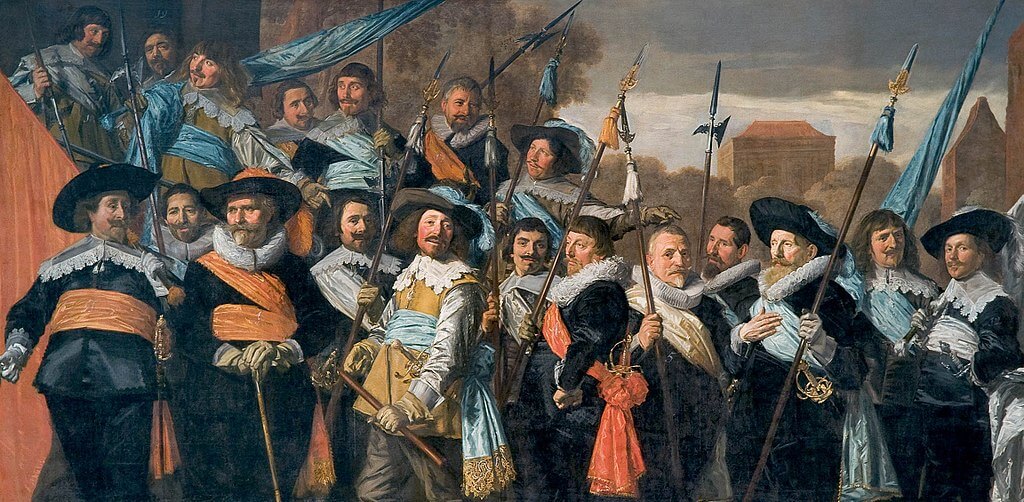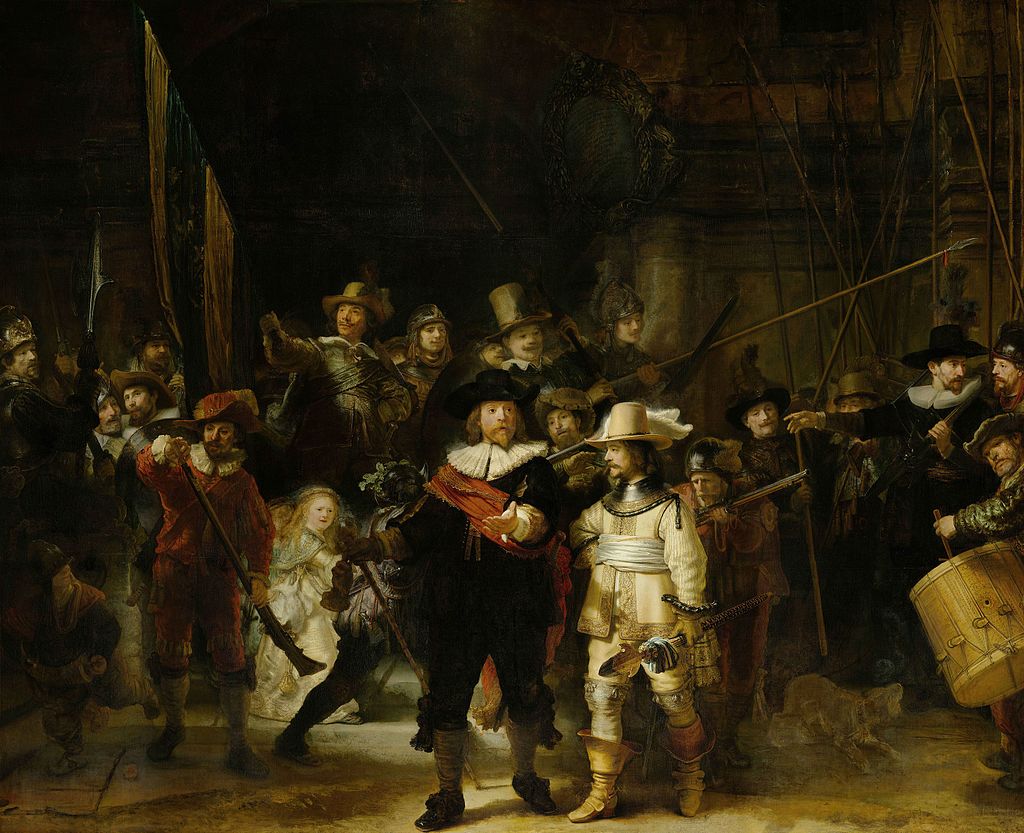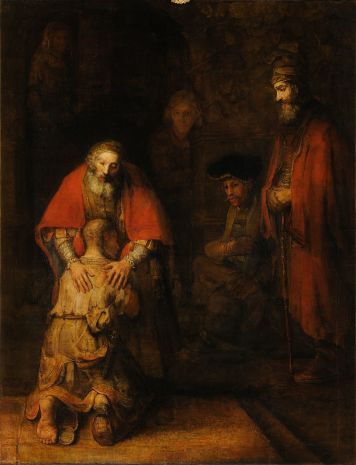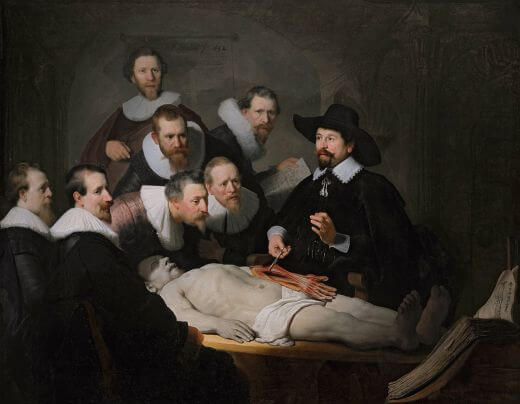|
Where? Gallery 14 of the Legion of Honor Museum
When? 1632 Commissioned by? Joris de Caullery What do you see? The portrait of a confident, 32-year old member of the civic guard in The Hague. Joris de Caullery is dressed in the costume of a civic guard member. He holds a type of musket (called a caliver) in his right hand and has his left hand on his hip. He wears a shiny shoulder-belt (called a bandolier) in which his sword hangs. Above the shoulder-belt, he wears a gorget, a piece of armor that covers the neck. But we can still see the purple-grey sleeves of his jacket and the sleeveless yellow doublet made of soft leather that he wears on top of the jacket. When he would get into action as a civic guard member, he would add a big piece of armor over that to protect himself. The cords of the doublet near his shoulders were used to attach the arm and shoulder pieces of his armor. Use of light: The young Rembrandt, only 26 years old, is already revolutionary in the way he incorporates light into his paintings. The contrast between light and dark allows him to emphasize the important elements of this portrait. Rembrandt illuminates parts of the armor and the tunic, as well as the face of Joris de Caullery. The ability to paint the soft flesh and detailed muscles and wrinkles around De Caullery’s eyes sets Rembrandt’s portraits apart from most of his contemporaries. However, this painting is not considered one of Rembrandt’s masterpieces. Over time, he would get even better in incorporating light in his paintings. For example, in this work, it is not so clear where the source of light is located. In later works, Rembrandt would incorporate the light more naturally, and we can understand better where the light is coming from. Backstory: In 1632, Rembrandt went to The Hague to create several portraits, among which the portrait of Joris de Caullery and a portrait of his son (which has not been identified with certainty yet). The painted came officially in possession of the Legion of Honor Museum in 1966 through a gift from the Roscoe and Margaret Oakes Foundation. What is the civic guard? Most cities in the 17th-century Dutch Republic had a civic guard. This was a voluntary organization consisting of citizens of the city to safeguard the city. A civic guard was typically led by one colonel, one provost, and a few captains, lieutenants, and sergeants. These people came from the upper class and taking such a leadership role was an honorary job. These people liked to be portrayed in this role. Frans Hals made several group portraits of the civic guard in Haarlem, including The Banquet of the Officers of the St George Militia Company in 1639 in the Frans Hals Museum. And in 1642, Rembrandt made the most famous of these group portraits. The Night Watch in the Rijksmuseum in Amsterdam shows the leaders of the Amsterdam civic guard. The bulk of the civic guard members, however, consisted of middle- and lower-class citizens of the city. There are few portraits of those people as they did not have the money to commission a portrait.
Who is De Caullery? Joris de Caulerij (or Caullery) lived between 1600 and 1661 in The Hague, close to the Mauritshuis, where he was a member of the civic guard. In 1635, he listed as one of the lieutenants in the civic guard. In his daily life, he worked in the navy where he became a captain and was praised for his courage.
After his military career, De Caullery became a successful wine merchant. During his life, he commissioned several well-known artists to make portraits of him and his wife. According to records, these artists included Anthony van Dyck and Jan Lievens. However, these other portraits – possibly except for one – have not been recovered yet. Who is Rembrandt? Rembrandt Harmenszoon van Rijn was born in 1606 in Leiden and died in 1669 in Amsterdam. Together with Frans Hals and Johannes Vermeer, he is considered to be the best painter from the Dutch Golden Age. Rembrandt was very productive during his career and was an excellent draughtsman, etcher, and painter. He painted a large variety of themes, including biblical, mythological, and contemporaneous subjects. Among them is The Return of the Prodigal Son in the Hermitage Museum in Saint Petersburg. Rembrandt also loved to paint portraits of himself, other individuals, and group portraits. Besides his famous The Night Watch, The Anatomy Lesson of Dr. Nicolaes Tulp in the Mauritshuis in The Hague is also a highly-admired work by Rembrandt.
Written by Eelco Kappe
References:
0 Comments
Leave a Reply. |
Categories
All
|
- Home
- Blog
-
Museums
- Alte Pinakothek
- Art Institute of Chicago
- Baltimore Museum of Art
- Barber Institute of Fine Arts
- Bargello
- Barnes Foundation
- British Museum
- Church of Sant’Anastasia
- Cleveland Museum of Art
- Courtauld Institute of Art
- Detroit Institute of Arts
- Frans Hals Museum
- Galleria Borghese
- Gallerie dell'Accademia
- Getty Museum
- Guggenheim
- Hermitage Museum
- Kunsthistorisches Museum
- Kunstmuseum Basel
- Legion of Honor Museum
- Louvre
- Mauritshuis
- Metropolitan Museum of Art
- Musee d’Orsay
- Museum of Fine Arts in Boston
- Museum of Modern Art
- National Gallery in London
- National Gallery of Art
- National Museum in Poznań
- Norton Simon Museum
- Ny Carlsberg Glyptotek
- Palace of Versailles
- Palazzo Pitti
- Palazzo Vecchio
- Petit Palais
- Philadelphia Museum of Art
- Prado
- Pushkin Museum
- Ravenna Art Museum
- Rijksmuseum
- San Diego Museum of Art
- Santa Maria delle Grazie
- St. Peter's Basilica
- Städel Museum
- Statens Museum for Kunst
- Tate Britain
- Tate Modern
- Timken Museum of Art
- Uffizi
- Vatican Museums
- Wallace Collection
-
Artists
- Altdorfer
- Anguissola
- Berlin Painter
- Bosch
- Botticelli
- Boucher
- Bronzino
- Bruegel the Elder
- Brunelleschi
- Cabanel
- Caillebotte
- Canova
- Caravaggio
- Carpeaux
- Cezanne
- Cimabue
- David
- Degas
- Delacroix
- De Maria
- Donatello
- El Greco
- Fontana
- Fra Angelico
- Fragonard
- Gauguin
- Gentileschi
- Gericault
- Gonzalez-Torres
- Goya
- Hals
- Hogarth
- Hokusai
- Ingres
- Leonardo da Vinci
- Lippi, Filippo
- Longhi, Barbara
- Lorrain
- Makovsky
- Manet
- Massys
- Matisse
- Merian
- Michelangelo
- Mochi
- Modigliani
- Monet
- Panini
- Parmigianino
- Perugino
- Picasso
- Pisanello
- Raphael
- Rembrandt
- Renoir
- Reynolds
- Rivera
- Rodin
- Rubens
- Scultori
- Seurat
- Steen
- Tintoretto
- Titian
- Toulouse-Lautrec
- Turner
- Uccello
- Van der Weyden
- Van Dyck
- Van Eyck
- Van Gogh
- Van Hemessen
- Vasari
- Velazquez
- Vermeer
- Veronese
- Vigée Le Brun
-
Locations
- Books
- About Us






